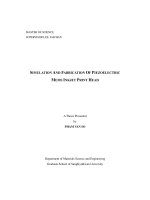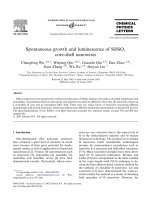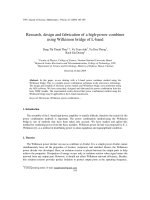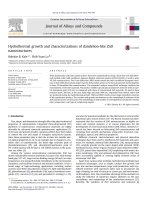Liquid phase epitaxial growth and fabrication of gallium phosphide green light emitting diodes
Bạn đang xem bản rút gọn của tài liệu. Xem và tải ngay bản đầy đủ của tài liệu tại đây (4.32 MB, 127 trang )
LIQUID PHASE EPITAXIAL GROWTH AND
FABRICATION OF GALLIUM PHOSPHIDE
GREEN LIGHT EMITTING DIODES
NG C HIEW HAI
[B.ENG (HONS), NUS]
A THESIS SUBMITTED
FOR THE DEGREE OF MASTERS OF ENGINEERING
DEPARTMENT OF ELECTRICAL ENGINEERING
NATIONAL UNIVERSITY OF SINGAPORE
2000
LPE GROWTH AND FABRICATION OF GAP GREEN LEDS
ABSTRACT
Nitrogen-doped gallium phosphide is a material that has been well established
for use in the fabrication of yellow-green light emitting diodes (LEDs) in the
optoelectronics industry.
The parameters involved in the liquid phase epitaxial
(LPE) growth of this material were studied and evaluated. It has been found that the
baking cycle prior to growth has a major impact on the thermal dissociation of
phosphorus from the substrate surface while growth temperature did not affect the
luminescence efficiency. Different schemes to protect the substrate from thermal
degradation were investigated. Keeping the substrate in a cool zone before growth
and covering it under the graphite boat were effective in preventing such
degradation. Nitrogen doping to introduce isoelectronic centers was incorporated in
the LPE system. This has to be well controlled as too little nitrogen resulted in dim
LEDs, while concentration levels above 0.1% in the gaseous phase resulted in
dendrite growths. A new LED fabrication process has been explored in the study,
and this has shortened the time needed to fabricate the device structure, which allows
electrical and optical tests to be performed on the wafers. The process defines both
the light emission region and the metal contact in a single masking step.
i
LPE GROWTH AND FABRICATION OF GAP GREEN LEDS
ACKNOWLEDGEMENT
I would like to thank my project supervisor, Professor Chua Soo Jin for his
guidance and advice throughout the course of this study, and for his understanding in
accommodating my work schedule. I am also grateful to the laboratory technicians,
Ms Musni and Mr Tan Beng Hwee in the Centre of Optoelectronics for their help, in
the ordering of supplies and maintenance of equipment.
I would also like to express my gratitude to my employer, Agilent
Technologies Singapore Private Limited for sponsoring the project and also to my
colleagues in the wafer fabrication department for their helpful discussions and
encouragement.
Last but certainly not least, my appreciation to my wife and family who have
rallied around me for these years.
A part-time experimental research study is
demanding, and I am glad to have tolerating family members who are understanding
and supported me through many late nights and “burnt” weekends.
ii
LPE GROWTH AND FABRICATION OF GAP GREEN LEDS
LIQUID PHASE EPITAXIAL GROWTH AND
FABRICATION OF GALLIUM PHOSPHIDE
GREEN LIGHT EMITTING DIODES
CONTENTS
ABSTRACT………………………………………………………………………..…....i
ACKNOWLEDGEMENT………………………………………………………………. .ii
LIST OF TABLES………………………………………………………………………v
LIST OF FIGURES………………………………………………………………….… vi
CHAPTER 1 INTRODUCTION........................................................................... 1
1.1
1.2
BACKGROUND ........................................................................................... 1
OBJECTIVES............................................................................................... 4
CHAPTER 2 EPITAXIAL TECHNOLOGIES.................................................... 6
2.1
2.2
2.3
MOLECULAR BEAM EPITAXY (MBE) ......................................................... 7
VAPOR PHASE EPITAXY (VPE) .................................................................. 9
LIQUID PHASE EPITAXY (LPE)................................................................. 12
CHAPTER 3 CONSIDERATIONS FOR LPE GROWTH OF GaP ................. 16
3.1
LIQUID PHASE EPITAXIAL GROWTH TECHNIQUES ..................................... 16
3.1.1 Ramp-cooled growth........................................................................... 16
3.1.2 Step-cooled growth ............................................................................. 17
3.1.3 Supercooled growth ............................................................................ 19
3.1.4 Transient mode growth ....................................................................... 19
3.2
GROWTH TEMPERATURE .......................................................................... 20
3.3
THERMAL DISSOCIATION OF PHOSPHORUS................................................ 23
3.4
JUNCTION FORMATION............................................................................. 25
3.4.1 Diffusion............................................................................................. 25
3.4.2 Two-step growth ................................................................................. 25
3.4.3 Over-compensation............................................................................. 25
3.4.4 Double melt ........................................................................................ 26
3.5
NITROGEN ............................................................................................... 26
3.5.1 Nitrogen Incorporation ....................................................................... 27
3.5.2 Measurement of Nitrogen Concentration............................................. 30
3.6
DOPANTS ................................................................................................ 33
3.7
THICKNESS OF LPE LAYERS ..................................................................... 35
3.8
OXYGEN CONTENT .................................................................................. 36
3.9
MELT THICKNESS .................................................................................... 37
3.10 RELIABILITY ............................................................................................ 38
iii
LPE GROWTH AND FABRICATION OF GAP GREEN LEDS
CHAPTER 4 EPITAXIAL GROWTH............................................................... 43
4.1
LPE REACTOR SETUP .............................................................................. 43
4.2
GRAPHITE BOAT DESIGN ......................................................................... 44
4.3
GAS DELIVERY SYSTEM........................................................................... 47
4.4
GROWTH RESULTS ................................................................................... 49
4.4.1 (100) substrate growths ...................................................................... 49
4.4.2 (111) substrate growths ...................................................................... 53
4.4.2.1
4.4.2.2
4.4.2.3
4.4.2.4
4.4.2.5
Doping concentration............................................................................ 53
Surface finishing................................................................................... 55
Effect of growth temperature on luminescence...................................... 63
Nitrogen doping.................................................................................... 64
Single layer multi-slice growth ............................................................. 68
CHAPTER 5 DEVICE FABRICATION ............................................................ 71
5.1
A NEW FABRICATION PROCESS ................................................................ 71
5.1.1 Top contact metallization.................................................................... 76
5.1.2 Masking .............................................................................................. 76
5.1.3 Reactive Ion Etching:.......................................................................... 78
5.1.4 Wet etch.............................................................................................. 79
5.1.5 Backetch/Backcontact ......................................................................... 81
5.2
ETCH RATES ............................................................................................ 81
5.3
OPTICAL/ELECTRICAL CHARACTERIZATION ............................................. 83
CHAPTER 6 CONCLUSION AND RECOMMENDATION ............................ 85
REFERENCES..................................................................................................... 88
APPENDIX A: MULTI-SLICE LPE SYSTEMS ............................................... 97
A.1 ALIQUOT ROTATOR ....................................................................................... 97
A.2 FLIPPER SYSTEM ........................................................................................... 99
A.3 DIPPER SYSTEM .......................................................................................... 100
A.4 THIN MELT SLIDER SYSTEM ......................................................................... 101
A.5 VAPOR DOPING OVERCOMPENSATION SYSTEM ............................................. 103
A.6 STACKED-SLIDER SYSTEM ........................................................................... 104
A.7 VERTICALLY STACKED SYSTEM ................................................................... 105
A.8 TWO MELT TYPE LPE SYSTEM ..................................................................... 106
A.9 MULTI-SUBSTRATE SLIDER SYSTEM ............................................................ 109
APPENDIX B: GRAPHITE BOAT DESIGN................................................... 113
APPENDIX C: EXPERIMENTAL PROCEDURES........................................ 116
C.1
C.2
C.3
PROCEDURE FOR GA BAKING.................................................................. 116
PROCEDURE FOR PUMPING DOWN THE REACTOR TUBE ............................. 117
PROCEDURE FOR LPE GROWTH .............................................................. 117
iv
LPE GROWTH AND FABRICATION OF GAP GREEN LEDS
LIST OF TABLES
Table 1: Material systems and quantum efficiencies of green LEDs [Cook,95],
[Craford,95]....................................................................................................... 4
Table 2: Characteristics of high and low growth temperatures in LPE .................... 21
Table 3: Summary of growth conditions and results for growths on (100) oriented
substrates......................................................................................................... 49
Table 4: Experimental conditions to evaluate factors for surface finishing.............. 57
Table 5: Comparison of EDX results of different wafers and theoretical atomic mass
ratio ................................................................................................................. 59
Table 6: Nitrogen concentration as a result of varying ammonia flow rates ............ 68
Table 7: Etch rates of different materials in RIE ..................................................... 82
v
LPE GROWTH AND FABRICATION OF GAP GREEN LEDS
LIST OF FIGURES
Figure 1: Temperature against time profile for ramp-cooled LPE growth method ... 17
Figure 2: Temperature against time profile for step-cooled LPE growth method..... 18
Figure 3: Temperature against time profile for supercooled LPE growth method.... 19
Figure 4: 6K PL spectra of GaP1-xNx alloys with various nitrogen concentration
[Yaguchi,97].................................................................................................... 30
Figure 5: Transmission spectrum obtained at 11K for a 0.1mm LPE layer containing
6.7×1017 nitrogen cm-3 grown on a 0.3mm LEC substrate containing 7×1014
nitrogen cm-3. Spectra are also shown for the substrate alone before and after
annealing for 1hr at 1000oC [Lightowlers,74] .................................................. 31
Figure 6: Typical PL spectrum at 4.2K for LPE grown GaP:N, showing the identity
of most of the peaks[Thierry-Meg, 83]............................................................. 33
Figure 7: Structure of GaP:N green LED, for efficient light generation and extraction
........................................................................................................................ 36
Figure 8: Equipment setup for LPE growth ............................................................ 43
Figure 9: Graphite slider with extended length for holding substrates and melt holder
with larger opening area................................................................................... 46
Figure 10: Isometric drawing for cover of melt holders, illustrating tapered holes .. 46
Figure 11: Side view of LPE reactor, showing position of furnace during baking
cycle ................................................................................................................ 47
Figure 12: Schematics of gas delivery system for the LPE reactor .......................... 48
Figure 13: Phase diagram for the Ga-P system, with data from various sources
[Astles,90] ....................................................................................................... 50
Figure 14: Plot of carrier concentration versus mole fraction of Te in melt. Published
results are from [Jordan, 73]. All growths are at 900oC. ................................... 54
Figure 15: Plot of carrier concentration versus mole fraction of Zn in melt. Published
results are from [Jordan,71]. All growths are at 900oC. .................................... 55
Figure 16: Wafer with good surface finish, which was covered under graphite boat
during baking, Typical LPE ripple pattern is seen. ........................................... 57
Figure 17: Wafer which was exposed during baking, resulting in poor surface finish,
poor nucleation and pits. .................................................................................. 58
Figure 18: EDX result in area with pits on degraded wafer ..................................... 60
vi
LPE GROWTH AND FABRICATION OF GAP GREEN LEDS
Figure 19: EDX result in region without pits on degraded wafer............................. 61
Figure 20: EDX result of wafer that was protected from degradation by covering the
substrate under the graphite during baking ....................................................... 62
Figure 21: Photoluminescence spectra of commercial and COE grown samples, done
at 900oC, NH3 flow rate of 16l/hr, H2 flow rate of 40l/hr and ramp rate of
3oC/min. .......................................................................................................... 64
Figure 22: Optical photograph at magnification of 400x, showing dendrite growth
resulting from excessive nitrogen doping ......................................................... 65
Figure 23: Comparison of PL spectra of wafers grown at different NH3 flow rates . 66
Figure 24: Variation of integrated PL intensity with ammonia flow rate ................. 67
Figure 25: Conventional process flow for LED wafer with isolated channel ........... 72
Figure 26: New process flow for LED wafer with isolated channel......................... 74
Figure 27: Top view of wafer after reflow of resist ................................................. 77
Figure 28: Surface profile across resist after reflow ................................................ 77
Figure 29: Top view of wafer after completion of RIE ........................................... 79
Figure 30: Surface profile of wafer, after RIE etch, before stripping of resist.......... 80
Figure 31: Top view of wafer after stripping resist, with bondpad defined .............. 81
Figure 32: I-V characteristics of GaP:N LED fabricated using conventional and new
process flows ................................................................................................... 83
Figure 33: Electroluminescence plot of a LPE grown GaP:N LED ......................... 84
Figure 34: Detailed mounting arrangement of aliquot rotator [Lorimor,73] ............ 98
Figure 35: (a) Construction details of the crucible, (b) completed assembly of the
rotator [Lorimor,73]......................................................................................... 98
Figure 36: Concept of flipper system for multi-slice growth. Insert shows the
operational sequence [Saul,74] ........................................................................ 99
Figure 37: Slider boat for aliquot formation [Berg,73].......................................... 101
Figure 38: Parts of the double slider LPE apparatus [Berg,73].............................. 102
Figure 39: Cross-sectional view of double slider LPE apparatus in operation
[Berg,73] ....................................................................................................... 102
Figure 40: Apparatus for Zn vapor doping for overcompensation growth of p-layer
[Saul, 74]....................................................................................................... 103
vii
LPE GROWTH AND FABRICATION OF GAP GREEN LEDS
Figure 41: Stacked slider LPE system, shown in initial(A) and growth(B) positions
[Saul, 74]....................................................................................................... 104
Figure 42: Vertically stacked system for LPE growth [Saul, 74]........................... 105
Figure 43: Schematic on boat designs by [Yamaguchi,76]. The figure shows the
state where Ga melts and GaP substrates are separated in two compartments
prior to the contacting operation by tipping or pulling.................................... 107
Figure 44: Schematic on boat designs by [Yamaguchi,76]. The figure shows the
state where Ga melts and GaP substrates are separated in two compartments on
top of the wafers. ........................................................................................... 109
Figure 45: Multi-slice LPE boat design allowing growth of up to four layers on up to
16 substrates [Heinen,85].............................................................................. 110
Figure 46: Improved version of multi-substrate slider. The first melt is undergoing
“aliquoting” [Dutt,84].................................................................................... 111
Figure 47: CAD drawing of new graphite boat and slider ..................................... 113
Figure 48: CAD drawing of previous graphite boat .............................................. 114
Figure 49: CAD drawing of previous graphite slider ............................................ 115
viii
INTRODUCTION
CHAPTER 1
INTRODUCTION
1.1 Background
Light emission from materials due to applied electric field, a phenomenon that
is termed electroluminescence [Round], has been reported since the early 20th
century. The materials properties were then poorly controlled, and the emission
processes were not well understood. For example, the first reports on light emitting
diodes (LEDs) [Round] were based on light emission from particles of silicon
carbide (SiC), which had been manufactured as sandpaper grit. The best SiC LEDs,
emitting blue light at 470 nm, managed to improve to an efficiency of only 0.03%,
after years of development.
Bulk growth of the III-V compound semiconductors commenced in 1954
[Nathan, 62]. Large single crystals boules of gallium arsenide (GaAs) were pulled
from the melt, and the sliced and polished wafers used as substrates for the epitaxial
growth of p-n junction diode structures. Infrared (870 – 980 nm) LEDs based on
GaAs were first reported in 1962 [Nathan, 62]. In order to get visible light emission,
GaAs was alloyed with gallium phosphide (GaP), and red LEDs (650 – 700 nm)
were soon demonstrated. It was determined that at room temperature, the highest
efficiency of GaAsP LEDs was about 0.2% starting with pure GaAs, and this value
dropped by several orders of magnitude to less than 0.005% when the phosphorus
concentration exceeded 44% [Maruska, 67].
It soon became apparent that GaP was not nearly as efficient a light emitter as
GaAs, due to an indirect bandgap. This means that GaP does not emit light
LPE GROWTH AND FABRICATION OF GAP GREEN LEDS
page 1
INTRODUCTION
efficiently due to the momentum conservation condition. The near bandgap radiation
of GaP peaks at about 560 nm and is very close to the wavelength of maximum eye
response. While the external quantum efficiency of GaP LEDs is less than that for
the red LEDs, the eye’s response to green light is 30 times more that of the red, so
the apparent brightness of the LEDs is comparable. This makes GaP potentially a
very useful visible semiconductor light source. Efficient green electro-luminescence
in nitrogen-doped GaP has been demonstrated for p-n junctions grown by liquid
phase epitaxy (LPE) [Astles, 90].
The commercial interest in this material for
display devices and discrete light emitting diodes has stimulated interest in
developing inexpensive LPE systems, capable of producing efficient p-n junctions.
This has propelled the evolution of LPE from a delicate laboratory technique into a
maturing technology suitable for high volume production of high quality junction
material.
Nitrogen (N) substitutes for phosphorus in GaP to form isoelectronic traps.
The peak wavelength of emission from N-doped GaP LED is longer than its bandgap
equivalent wavelength of 560 nm at room temperature, giving a yellowish-green
color. These LEDs have become the primary material system for standard, low
brightness green LEDs as they are visually appealing and have higher efficiencies
than pure GaP green LEDs (without nitrogen doping), as can be seen in Table 1.
They are widely used in visual display applications such as backlighting of liquid
crystal display (LCD) panels and indicators.
Agilent Technologies (previously part of Hewlett-Packard Company) has been
a leading optoelectronics manufacturer, with in house capability for bulk crystal
growth, epitaxial growth, wafer fabrication, die preparation, and backend assembly.
Its range of LED products include the full visible spectrum for display applications,
LPE GROWTH AND FABRICATION OF GAP GREEN LEDS
page 2
INTRODUCTION
infrared for communication purposes, and long wavelength devices for use in optical
fibre communications. In several products, such as the yellow, orange and red
visible LEDs, and the communication devices, Agilent dominates the market with its
superior technology. One exception is that for the yellow-green GaP:N LEDs, the
epitaxial wafers are purchased from external vendors, with wafer fabrication done in
house. The GaP:N industry has been dominated by a few major wafer suppliers,
such as Showa Denko, Shinitsu and Stanley, all growing the wafers by LPE. The
fact that the industry suppliers are all using LPE for the growth of GaP:N suggests
that this is the preferred technology for this application. Due to the commercial
nature of the material system, there is not much literature published detailing the
process of the epitaxial growth.
In Singapore, the Agilent operation has a wafer fabrication facility, but no
epitaxial capability. Collaboration was initiated in 1994 with the National University
of Singapore to investigate the issues involved in the LPE growth of GaP:N LEDs.
The aim is to gain some experience and knowledge in the area of epitaxial growth,
for future application, if and when there is a need to set up an epitaxial plant in
Singapore, and to be able to port the process to a high volume manufacturing
environment, if there is any success in the work.
At the targeted range of wavelength (for green emission), other material
systems that could be used include AlInGaP, ZnTeSe and InGaN. Table 1 lists
typical material systems used and quantum efficiencies that have been obtained
{[Cook, 95], [Craford, 94]}. However, these require other growth technologies such
as Molecular Beam Epitaxy (MBE) or Metal-organic Chemical Vapour Deposition
(MOCVD), which demand a longer setup time and larger capital investment. For
indoor display applications, the performance obtainable from LPE growth of GaP is
LPE GROWTH AND FABRICATION OF GAP GREEN LEDS
page 3
INTRODUCTION
sufficient. Large outdoor panel displays require higher brightness LED technologies
to provide daylight viewability.
Table 1: Material systems and quantum efficiencies of green LEDs [Cook,95],
[Craford,95]
Material System
Growth Technology
Typical Quantum
Efficiency (%)
Typical performance
(l/W)
GaP
LPE
0.1
2.5
GaP : N
LPE
0.3
0.6
AlInGaP
MBE, MOCVD
1.0
6.0
ZnTeSe
MOCVD
5.3
-
InGaN
MOCVD
3.8
-
The other growth technologies will be discussed briefly in chapter 2.
1.2 Objectives
The primary objective of the project is to grow GaP epitaxial layers with high
electrical luminescence efficiency and with a peak wavelength around 572nm by
means of LPE. It is also necessary to develop a device fabrication process so that the
wafers grown can be fabricated into GaP LEDs with high external quantum
efficiency. The growth conditions and parameters for the processes should be such
that the process can be eventually implemented on a large-scale manufacturing basis.
This thesis is organized as follows:
•
Chapter 1 describes the background and objectives of the study.
•
Chapter 2 briefly introduces the different epitaxy technologies, and covers some
aspects of LPE in general.
LPE GROWTH AND FABRICATION OF GAP GREEN LEDS
page 4
INTRODUCTION
•
Chapter 3 surveys the parameters critical to the LPE growth of GaP and reviews
the results that have been reported in the literature. The published results for GaP
growth are analyzed and the optimum structure for GaP:N LEDs chosen.
•
Chapter 4 describes the experimental setup and procedures used in the current
study, followed by the results and findings in the current research.
•
Chapter 5 presents the procedure appropriate for fabricating the grown wafers
into devices, in order to test for optical and electrical results.
•
Chapter 6 concludes the thesis, suggests some areas for improvement and
recommends some future research ideas.
LPE GROWTH AND FABRICATION OF GAP GREEN LEDS
page 5
EPITAXIAL TECHNOLOGIES
CHAPTER 2
EPITAXIAL TECHNOLOGIES
The term epitaxy may be defined as the deposition of a single crystal layer on a
single crystal substrate in such a way that the crystalline structure is continued into
the layer. From this definition of epitaxy, two conditions must be satisfied:
i. Crystal structures of layer and substrate should have the same crystallographic
space group.
ii. Unit cell dimensions or lattice parameter of the layer and substrate should be
closely matched. In general, if the lattice mismatch, ε, defined as
ε =
where
aL - aS
,
aav
aL = lattice parameter of the layer;
aS = lattice parameter of the substrate; and
aav = ½(aL + aS),
has a value ε ≤ 10-3, then epitaxial growth will occur although with some
distortion of the unit cell of the epitaxial layer in order to maintain exact lattice
plane continuity across the substrate-layer interface.
For ε > 10 -3 there is
increasing tendency towards the generation of misfit dislocations either at the
interface or as threading dislocations, with an increasing difficulty in nucleating
the epitaxial layer growth.
For device quality materials of high efficiency, the internal non-radiative losses
must be low. The layers must have low interfacial stresses and low interfacial
recombination velocities. This can be achieved if they are lattice matched to each
other.
LPE GROWTH AND FABRICATION OF GAP GREEN LEDS
page 6
EPITAXIAL TECHNOLOGIES
There are three main epitaxial techniques for the growth of semiconductor
materials, each of which has several variations. They are Molecular Beam Epitaxy
(MBE), Vapor Phase Epitaxy (VPE), and Liquid Phase Epitaxy (LPE). Whereas
conventional LEDs are still grown by LPE, the vast majority of today's high
brightness LEDs (HB-LEDs) and laser diodes (LDs) are grown by Organo-Metallic
Vapor Phase Epitaxy (OMVPE), a variant of VPE. Complex heterostructure
electronic devices, such as the heterobiopolar transistors (HBTs) and high electron
mobility transistors (HEMTs) and advanced solar cells are grown by either MBE or
OMVPE.
2.1 Molecular Beam Epitaxy (MBE)
MBE may be described as a sophisticated evaporation technique performed in
ultra-high vacuum (UHV). In this growth process, the constituent atoms of the
epitaxial layer are supplied to the hot substrate as beams of particles, usually
obtained by evaporating the elements in a heated effusion cell. The substrate is
placed in the high vacuum and elemental species are evaporated from ovens/effusion
cells and impinge upon the heated substrate, where they assemble into crystalline
order.
The atoms travel without collision to the substrate.
Surface kinetics is
therefore of primary importance in MBE. With proper control of the source (e.g.
Ga, As, Al, Si, etc), almost any material composition and doping can be achieved.
Furthermore, the composition can be controlled with a resolution of virtually one
atomic layer [Adams, 90].
MBE has significant advantage over the other growth technologies, but is much
more expensive. One key advantage of MBE is the ability to desorb in situ the oxide
on the surface just prior to growth and then determine if it has taken place by its
LPE GROWTH AND FABRICATION OF GAP GREEN LEDS
page 7
EPITAXIAL TECHNOLOGIES
reflection electron-diffraction pattern. This glancing-incidence technique shows the
surface changing from amorphous to crystalline when successfully cleaned. It is also
possible to determine the average atomic ordering of the surface from the pattern of
diffracted spots. It can also monitor the film as it grows. Other advantages follow
from the fact that MBE is an ultra-high-vacuum technique.
Surface analysis
techniques, such as Auger electron spectroscopy, can be included in the growth
chamber. Present day growth kits usually have load-locked entry ports, substrate
exchange mechanisms, separate preparation chambers and even linked chambers
where dielectric and metal layers can be deposited. These features are all made
feasible by virtue of the UHV environment necessary for reproducible growth.
Another good point is that it can produce almost any epitaxial layer composition,
layer thickness and doping and can do so with high accuracy and uniformity across a
wafer.
Limitations of MBE include stringent high vacuum requirement (10-10 to 10 -11
Torr), which is an exceedingly difficult requirement in the presence of heated
substrates and effusion ovens. In practice this translates to long downtime for the
growth system. Complex and costly equipment and slow growth rate (~1µm/h to 10
µm/h) add further to the cost of production.
Three variations of MBE are:
i. Migration enhanced epitaxy (MEE) or migration enhanced MBE (MEMBE),
which is a process in which the group III and group V atoms are sequentially
deposited on the wafer by alternating the shutter openings on the Ga and As
sources, for example. In conventional MBE, both shutters are open at the same
time and both types of atoms together impinge upon the wafer. The intent is to
LPE GROWTH AND FABRICATION OF GAP GREEN LEDS
page 8
EPITAXIAL TECHNOLOGIES
give the group III atoms some time to migrate over the wafer surface to yield a
more perfect structure, possibly even at lower growth temperature.
This is
especially studied for growth of GaAs epitaxial layers on Si substrates.
ii. Atomic layer epitaxy (ALE), which is much like MEE, except that the emphasis
is to form one atomic layer of each species at a time. The potential advantage of
this technique is based on the fact that the first atomic layer is bound mainly by
chemisorption, which is strong, while subsequent atomic layers (of the same
species) are bound by physisorption, which is less strong. By appropriately
adjusting the growth temperature, the process is intended to be self-regulatory:
one atomic layer will form, but not a second. This self-regulatory feature has
uniformity and compositional advantages. Further, the technique has the ability
to grow on sidewalls, (e.g. of an etched trench) in more complex applications.
iii. Metal-organic MBE (MOMBE), where metal-organic sources commonly used in
MOVPE is used, e.g. triethylgallium may be used as the Ga source in the
machine, gases such as arsine and phosphine may be used as the group V source.
Its major advantage is reducing the frequency and difficulty of replacing the
material sources within the MBE machine. In conventional MBE, the machine
must be opened to air and the effusion oven cooled to replenish material. This
must be done rather often, and it is a slow process, which can require several
initial runs to re-establish purity and control.
2.2 Vapor Phase Epitaxy (VPE)
In VPE growth, the atoms are brought to the wafer in a gaseous phase. Under
appropriate temperatures and other conditions, reactions take place on the substrate
surface that result in these atoms being deposited on the surface, where they replicate
LPE GROWTH AND FABRICATION OF GAP GREEN LEDS
page 9
EPITAXIAL TECHNOLOGIES
the underlying crystal structure. VPE is generally a slow growth process, normally
of the order of 20-30µm/h, the growth rate being controlled by gas flows and
substrate conditions. More complicated apparatus is required for gas handling and
more complex temperature zones have to be established in the furnace.
There are two basic classes depending on the gas system employed:
i. Trichloride process: (e.g. InGaAsP system) AsCl3 and PCl3 are passed over
elemental Ga or In to form metal chlorides, or over binary wafers such as GaAs
and InP.
ii. Hydride process: HCl gas is passed over hot In or Ga metal to generate the metal
chlorides and then combined with cracked hydrides of arsenic (AsH3) and/or
phosphorous (PH3).
Advantages of VPE include ease of scaling up to manufacturing conditions
from the research setup, and real-time monitoring (e.g. gravimetric, optical) of the
growth can be done. Electrobalances have been used to record the change in weight
of the substrates as the epitaxial layers are deposited.
In VPE growth, it is difficult to achieve sharp interfaces between layers simply
by rapidly changing the inlet gas composition. This is because the deposited layer is
a function of the gas-stream composition in the vicinity of the substrate and it is
inevitable that there is a delay before the sample’s ambient experiences the change.
Also the resultant gas composition may not accurately reflect the inlet changes. The
multi-barrel VPE reactor was designed to resolve this problem. In the scheme, the
gas compositions required for the targeted solid compositions are set up and
stabilized in separate chambers or barrels.
LPE GROWTH AND FABRICATION OF GAP GREEN LEDS
To change layer compositions, the
page 10
EPITAXIAL TECHNOLOGIES
substrate is presented to the relevant chamber. VPE also suffers from attack of the
hot silica glassware in the hot wall reactor by the reactant gases.
One important variation of the VPE technique is metal-organic vapor phase
epitaxy (MOVPE), also known as metal-organic chemical vapor deposition
(MOCVD) or organo-metallic chemical vapor deposition (OMCVD). In this growth
technique, the group III elements are introduced in the form of metallic alkyls, e.g.
Ga(CH)3 or trimethylgallium (TMGa), as opposed to the chloride or trichloride
transport used in conventional VPE, and a cold wall reactor is used.
Growth is achieved by introducing precisely metered amounts of the Group III
alkyls and the Group V hydrides, usually via mass flow controllers, into a quartz
reaction tube. The substrate is placed in this tube and heated on a carbon susceptor
using RF induction. The hot substrate and susceptor have a catalytic effect on the
decomposition of the gaseous products and the growth takes place primarily at the
hot surface, the substrate acting as a template for the arrangement of the deposited
atoms onto a lattice-matched epitaxial layer.
The reactor design is simplified as only the sample and its holder need to be
heated. Group V hydrides, e.g. AsH3, PH3, may again be used, although these can be
obtained in metallorganic form. It is possible, using MOCVD (and also MBE – see
section 2.1), to grow epitaxial layers with more lattice mismatch (ε > 10 -1) or with
different crystal structures, e.g. GaAs on Si, since high degree of supersaturation is
possible.
Low pressure MOCVD has been used to produce layers that are sufficiently
thin and abrupt to show size quantization effects. This technique has evolved from
low pressure MOCVD of Si in which the reduced pressure lowered the dopant vapor
LPE GROWTH AND FABRICATION OF GAP GREEN LEDS
page 11
EPITAXIAL TECHNOLOGIES
pressure above a heavily doped substrate. Without this measure, subsequent high
purity layers were unintentionally doped - the autodoping effect. The technique has
also eliminated the parasitic reaction of TMIn with the hydrides (e.g. PH3), which
leads to fumes, formation of additional compounds and the depletion of the vapor
phase.
One major concern with MOVPE is the safety requirements associated with the
toxic gases, such as arsine and phosphine. Attempts have been made to replace
arsine with other sources of arsenic such as tertiarybutylarsine (TBA), which is a
liquid and is much safer to handle and use.
2.3 Liquid Phase Epitaxy (LPE)
Liquid phase epitaxy normally refers to growth of epitaxial layers from
solutions at elevated temperatures. This is the most widely used and relatively least
costly epitaxial growth technique. In the growth of GaP:N green LEDs, LPE is the
established choice of the industry due to its low operational cost, high growth rate
and high efficiency.
The growth is normally done in a sliding graphite boat. In the stationary
section are a number of wells, which contain the melt constituents required for the
various layers of the structure, e.g. GaP dissolved in Ga. In addition, there may be
melts for in situ etching of the substrate prior to deposition to remove thermally
damaged surface layers or surface contamination. The melts are homogenized at the
saturation temperature and then the furnace temperature lowered.
The
supersaturation so produced in the melt is the driving force for nucleation on the
substrates. The substrates are moved under each melt in turn for the required time to
grow the desired thickness of each layer.
LPE GROWTH AND FABRICATION OF GAP GREEN LEDS
page 12
EPITAXIAL TECHNOLOGIES
Melt-casting technique, where a large quantity of material is prepared and cast
into several melts so as to reduce weighing error, has been used to improve accuracy
and uniformity of wavelength in laser structures. It can also improve reproducibility
in mass production systems.
The advantages that LPE has to offer are that
i. High luminescence efficiency due to the low concentration of non-radiative
centers and deep levels.
ii. Growth of ternary and quaternary alloys to greatly extend the range of material
properties available.
iii. Controlled n-type and p-type doping with a wide variety of dopants available.
iv. Ability to grow multi-layer structures, e.g. p-n junctions, heterostructures with
low interface recombination velocities.
v. Good reproducibility and uniformity of materials properties over large areas as it
is a near equilibrium process.
vi. Equipment that is cheaper to construct and operate. Many systems, as shown in
Appendix A, have also been designed for multiple wafer growths.
There are several aspects in which LPE is not so advantageous, mainly related
to the more recent development in semiconductor device technology which require
larger device structure or exceptional thickness and doping control:
i. It is difficult to grow large areas (>2cm2) of material that are free of surface
blemishes (e.g. for transmission photocathodes or integrated circuits). Defects
such as terraces, pinholes, and meniscus lines tend to be present.
LPE GROWTH AND FABRICATION OF GAP GREEN LEDS
page 13
EPITAXIAL TECHNOLOGIES
ii. It is also challenging to grow very abrupt interfaces, or precisely controlled
doping or composition profiles (e.g. for Gunn or IMPATT diodes).
iii. Where extremely accurate layer thickness uniformity and reproducibility are
required (e.g. for microwave FETs and quantum well structures), MBE or
MOCVD offer much better results.
iv. When compositional grading is required to overcome lattice mismatch between
layer and structure. It is difficult to grow abrupt hetero-epitaxial layers
Some variations of LPE are:
i. Electroepitaxy or current controlled LPE, in which an electric current is passed
through the solid-liquid interface to stimulate layer growth. It has been shown
that reproducible increases in doping level could be obtained by increasing the
current density during growth.
ii. LPE with controlled vapor pressure (CVP), whereby an optimal phosphorous
pressure is applied over the melt to achieve layers with less defects such as deep
levels or vacancies. Better crystal quality material and higher efficiency devices
have resulted from this method.
It can be seen that LPE, as a matured technology, is still appealing in low cost
applications. Traditionally, GaP:N LEDs have been grown by LPE as it is able to
grow thick layers of high quality epitaxial material in a shorter time than the other
technologies at a much lower cost, in large quantities. The device structure of GaP:N
LEDs does not need the precise control of epitaxial thickness offered by MBE and
MOCVD. The complexity and relatively poorer understanding of the MBE and
MOCVD systems result in longer setup time and downtime for maintenance and
troubleshooting compared to the simpler and more developed LPE technology. The
LPE GROWTH AND FABRICATION OF GAP GREEN LEDS
page 14
EPITAXIAL TECHNOLOGIES
cost of setting up and running MBE and MOCVD systems is in the order of millions
of dollars, while setting up a LPE system is in the order of tens of thousands of
dollars. The ease in scaling up to multiple wafer growth also allowed manufacturers
to increase the supply of the wafers easily, to cope with increased demand. The wide
spread use of LEDs in display applications such as indicator lamps and backlighting
means that GaP wafers need to be supplied in large quantities. In order to meet the
market demand in terms of cost and ability to supply the volume needed, LPE is the
favored technology for growth of GaP:N LEDs.
Details of LPE growth, in particular those pertaining to GaP:N LEDs, are
described in the following chapter.
LPE GROWTH AND FABRICATION OF GAP GREEN LEDS
page 15
CONSIDERATIONS FOR LPE G ROWTH OF GAP
CHAPTER 3 CONSIDERATIONS
FOR
LPE
GROWTH OF GaP
In this chapter, the published results on the considerations and growth
conditions for LPE growth of GaP LEDs are consolidated and analyzed. Factors
such as techniques of cooling to produce the supersaturation, growth temperature,
dopants used, junction formation and issues that are peculiar to the GaP material
system including phosphorus dissociation, nitrogen incorporation and oxygen
contamination are discussed. The device structures for efficient optical emission and
reliability aspects are also covered.
3.1 Liquid Phase Epitaxial Growth Techniques
The basis of LPE is the production of supersaturation in the growth solution,
such that deposition of solid material occurs onto the substrate. The supersaturation
can be produced in several ways, as described in the following sections [Astles, 90].
Other techniques are available but those are not readily implementable in a mass
production system and will not be explored here.
3.1.1 Ramp-cooled growth
In this technique, the temperature of the melt is lowered at some rate R
(oC/min) from the liquidus temperature (TL) to a temperature TL - ∆TR while in
contact with the substrate. The temperature versus time profile for the growth period
is illustrated in Figure 1. Typical ramp rate is of the order of 1 oC/min [Saul, 71].
Layer thickness (d) varies with growth time (t) according to the relationship
d ∝ t3/2
LPE GROWTH AND FABRICATION OF GAP GREEN LEDS
page 16









